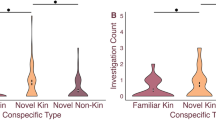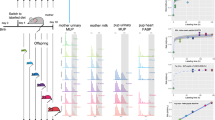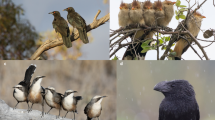Abstract
HOUSE mice (Mus musculus domesticus) form communal nests and appear to nurse each other's pups indiscriminately. Communal nesting probably functions to reduce infanticide1, but it also makes females vulnerable to exploitation if nursing partners fail to provide their fair share of care. Kinship theory predicts that females will preferentially form communal nests with relatives to minimize exploitation and further increase inclusive fitness2–4. Here we provide evidence from seminatural populations that females prefer communal nesting partners that share allelic forms of major histocompatibility complex genes. Such behaviour would lead to the selection of close relatives as communal nesting partners5–7. Although criteria for the demonstration of kin recognition are currently embroiled in controversy8,9, this is the first vertebrate study to meet Grafen's restrictive requirements8,10: discrimination is based on genetic similarity at highly polymorphic loci, incidental correlations due to relatedness are experimentally controlled, and strong reasons exist for expecting the assayed behaviour to be kin-selected.
This is a preview of subscription content, access via your institution
Access options
Subscribe to this journal
Receive 51 print issues and online access
$199.00 per year
only $3.90 per issue
Buy this article
- Purchase on Springer Link
- Instant access to full article PDF
Prices may be subject to local taxes which are calculated during checkout
Similar content being viewed by others
References
Manning, C. J., Dewsbury, D. A., Wakeland, E. K. & Potts, W. K. Anim. Behav. (in the press)
Hamilton, W. D. J. theor. Bio. 7, 1–52 (1964).
Wilkinson, G. S. & Baker, A. E. M. Ethology 77, 103–114 (1988).
Packer, C., Lewis, S. & Pusey, A. Anim. Behav. 43, 265–281 (1992).
Getz, W. M. J. theor. Bio. 92, 209–226 (1981).
Beecher, M. D. Am Zool. 22, 477–490 (1982).
Lacy, R. C. & Sherman, P. W. Am. Nat. 121, 489–512 (1983).
Grafen, A. Anim. Behav. 39, 42–54 (1990).
Barnard, C. J., Hurst, J. L. & Aldous, P. Biol. Rev. 66, 377–430 (1991).
Barnard, C. Trends Ecol. Evol. 310, 312 (1991).
Klein, J. Natural History of the Major Histocompatibility Complex (Wiley, New York, 1986).
Thomas, L. in Fourth International Convocation of Immunology (eds Neter, E. & Milgrom, F.) 2–11 (Karger, Basel, 1975).
Brown, J. L. in Ethical Questions in Brain and Behavior (ed. Pfaff. D. W.) 111–124 (Springer, New York, 1983).
Grosberg, R. K. & Quinn, J. F. Nature 322, 456–459 (1986).
Partridge, L. Philos. Trans. R. Soc. B319, 525–539 (1988).
Uyenoyama, M. K. in The Evolution of Sex (eds Michod, R. E. & Levin, B. R.) 212–232 (Sinauer, Sunderland, MA, 1988).
Potts, W. K. & Wakeland, E. K. Trends Ecol. Evol. 5, 181–187 (1990).
Beauchamp, G. K., Yamazaki, K., Duncan, H., Bard, J. & Boyse, E. A. in Chemical Signals in Vertebrates V (eds MacDonald, D. W., Muller-Schwarze, D. & Natynczuk, S. E.) 244–254 (Oxford Science Publications, Oxford, 1990).
Beauchamp, G. K., Yamazaki, K., Bard, J. & Boyse, E. A. Behav. Genet. 18, 537–547 (1988).
Egid, K. & Brown, J. L. Anim. Behav. 38, 548–549 (1989).
Potts, W. K., Manning, C. J. & Wakeland, E. K. Nature 352, 619–621 (1991).
Oka, H. in Profiles of Japanese Science and Scientists 1970 (ed. Yukawa, H.) 196–206 (Kodansha, Tokyo, 1970).
Scofield, V. L., Schlumpberger, J. M., West, L. A. & Weissman, I. L. Nature 295, 499–502 (1982).
Hurst, J. L. & Barnard, C. J. Behav. Ecol. 3, 196–206 (1992).
Yamazaki, K. et al. Science 240, 1331–1332 (1988).
Author information
Authors and Affiliations
Rights and permissions
About this article
Cite this article
Manning, C., Wakeland, E. & Potts, W. Communal nesting patterns in mice implicate MHC genes in kin recognition. Nature 360, 581–583 (1992). https://doi.org/10.1038/360581a0
Received:
Accepted:
Issue Date:
DOI: https://doi.org/10.1038/360581a0
This article is cited by
-
A meta-analysis on the potency of foot-and-mouth disease vaccines in different animal models
Scientific Reports (2024)
-
Cryptic kin discrimination during communal lactation in mice favours cooperation between relatives
Communications Biology (2023)
-
Frontal neurons driving competitive behaviour and ecology of social groups
Nature (2022)
-
Why have aggregative multicellular organisms stayed simple?
Current Genetics (2021)
-
MHC class I diversity predicts non-random mating in Chinese alligators (Alligator sinensis)
Heredity (2019)
Comments
By submitting a comment you agree to abide by our Terms and Community Guidelines. If you find something abusive or that does not comply with our terms or guidelines please flag it as inappropriate.



